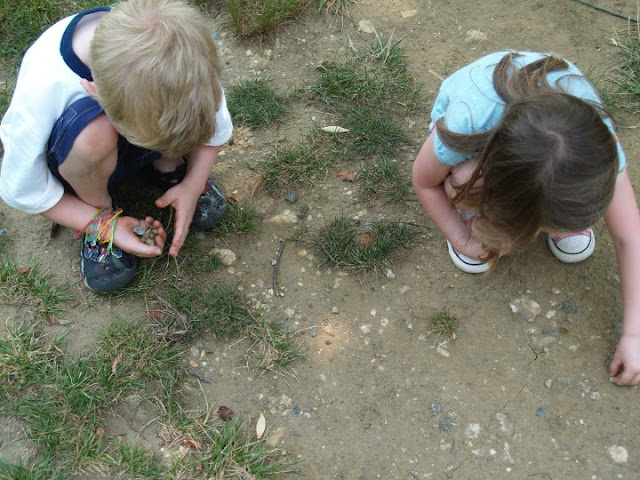The Science Behind Nature: What are the Benefits?
Young children learn about the world around them every day by interacting with people, things, and their environment (National Association for the Education of Young Children [NAEYC], 2020). They learn to ask questions, make observations, use their senses to explore, identify patterns, and make predictions. It should be no surprise that there are benefits to including natural play and exploration into the daily rhythm of our youngest learners. Early childhood is a crucial time for the development of young children, greatly impacted by interacting with the natural environment to develop healthy growth (Poppell & Monroe, 2015).
So, are there really benefits to spending time in nature? For our youngest learners, the benefits are outstanding! Spending time in nature supports development across all domains including cognitive, social, emotional, and physical development (Natural Learning Initiative, 2012). Exposure to and spending time in nature positively impacts a child's growth, development, and well-being in a multitude of ways:
 |
Figure 1 My children exploring the earth to find treasures (aka - rocks!). |
However, numerous barriers are limiting the opportunities that the young children in our care have for rich, natural interactions (Natural Learning Initiative, 2012). Children are spending more time indoors and less time actively engaged in outdoor activities. The average American child spends only about 30 minutes in free daily outdoor play but spends more than seven hours indoors in front of a screen (National Wildlife Federation, n.d.). This lack of interaction with the natural world has impacted children's health and well-being as we see more and more children with obesity, ADHD, and asthma, just to name a few (McCurdy et al., 2010, as cited in Poppell & Monroe, 2015). Schools are focusing on more structure, testing, and rigorous academic learning, greatly diminishing the time educators have to provide outdoor experiences for their students (Fine, 2018). Schools and families also struggle with finding safe and appropriate natural outdoor spaces for children to explore and play, concerned with neighborhood safety, crime, strangers, and busy schedules.
 |
Figure 2 Increase in academic rigor. |
So, are there really benefits to spending time in nature? For our youngest learners, the benefits are outstanding! Spending time in nature supports development across all domains including cognitive, social, emotional, and physical development (Natural Learning Initiative, 2012). Exposure to and spending time in nature positively impacts a child's growth, development, and well-being in a multitude of ways:
- When children are engaged in free play in natural settings they are more creative, better at problem-solving, and work more cooperatively with their peers (Bell & Dyment, 2006; Kellert, 2005, as cited in Natural Learning Initiative, 2012).
- Spending time in nature increases children's ability to focus (Wells, 2000, as cited in Natural Learning Initiative, 2012). Students as young as five with Attention Deficit Disorder also see a decrease in their symptoms (Kuo & Taylor, 2004, as cited in Natural Learning Initiative, 2012).
- Schools that incorporate outdoor classrooms or nature-based experiential learning, help improve students' academic performance across all subject areas (American Institutes for Research, 2005, as cited in Natural Learning Initiative, 2012).
- Exposure to green spaces helps children to have a happier disposition and get along with others, feel at peace, and have better self-control (Burdette & Whitaker, 2005; Taylor, Kuo & Sullivan, 2001, as cited in Natural Learning Initiative, 2012).
- A natural environment, including those with an abundance of plant life, expansive green space, and natural play areas, helps to reduce stress in children (Wells & Evans, 2003, as cited in Natural Learning Initiative, 2012).
- Children who spend time playing and exploring in natural landscapes are more physically active and show reduced instances of myopia (Bell & Dyment, 2006; American Academy of Ophthalmology, 2011, as cited in Natural Learning Initiative, 2012).
Children are born curious and eager to learn all about the world around them (NAEYC, 2020). It is our responsibility as early childhood educators to ensure that children, from birth to age eight, have an equitable right to learn and make connections through experiences in the real world. It is vital that we consider the young child and the awe and joy that comes with exploring and learning new things. Building a love of learning starts now. Incorporating early childhood environmental education helps children expand their knowledge about the natural world while developing positive feelings toward taking care of all living things in the environment (NAAEE, 2010, as cited in Poppell & Monroe, 2015). To secure the appropriate development of our youngest learners, we must work to close the nature gap (Poppell & Monroe, 2015). Early childhood environmental education is the experience that our students need to reconnect with nature, build positive behaviors and skills, and encourage their curiosity for a lifetime of wonder and learning.
References
Fine, M. (2018).
"There's a hole in the tree!": Kindergarteners learning in an
urban park. Young Children, 73(5), 8-13.
National Association for
the Education of Young Children. (2020).
Developmentally appropriate practice [Position statement]. https://www.naeyc.org/sites/default/files/globally-shared/downloads/PDFs/resources/position-statements/dap-statement_0.pdf
National Wildlife Federation. (n.d.). Health
Benefits and Tips.
Natural Learning
Initiative. (2012). Benefits of connecting children
with nature: Why naturalize outdoor learning environments. Natural Start. https://naturalstart.org/sites/default/files/benefits_of_connecting_children_with_nature_infosheet.pdf
Poppell, K. & Monroe,
M. (2015). Why is exposure to nature important in
early childhood? Institute of Food and Agricultural Sciences at the University of Florida. https://edis.ifas.ufl.edu/publication/FR394



Comments
Post a Comment